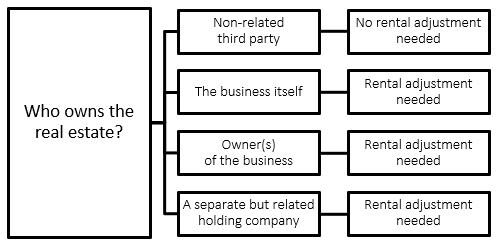13 Oct Arm’s Length vs. Non-Arm’s Length Transactions: How Does This Affect the Value of Your Company?
In real estate, arm’s length transactions refer to a business deal where parties involved have no previous relationship prior to negotiating an agreement. In this type of transaction, the buyer and seller act independently without one party influencing the other. However, in a non-arm’s length transaction, also known as an arm-in-arm transaction, the buyers and sellers have an existing relationship, whether business-related or personal. Commonly in a non-arm’s length transaction, either the company itself owns the real estate, the owner(s) of the business personally own(s) the real estate, or a separate but related holding entity owns the real estate.
When determining the fair market value of a business, a company’s rent expense must be first evaluated to determine if it was an arm’s length transaction or a non-arm’s length transaction. A company’s rent expense is one of a company’s largest expense and can therefore also affect the value of a business. Generally, if the real estate is leased from an unrelated third party in an arm’s length agreement, a rent adjustment will likely not have to take place. However, if the rental agreement falls into the category of a non-arm’s length transaction, then a rent adjustment will have to be made to find the fair market value of a business. Because this pre-existing relationship between the tenant and landlord, the owner of the company may be leveraging that relationship to better negotiate the amount of rent the company pays or reports on its income statement as opposed to a fair market value. A valuation analyst must assume that a hypothetical buyer of the business would not benefit from the existing relationship between the business and real estate.
 In order to find the fair market value of a business in an arm’s length rental agreement, the actual rent paid by the company (if any) is added back to its net income and then the fair market rent value is subtracted. Here are a few recommended methods to determine a fair market rent:
In order to find the fair market value of a business in an arm’s length rental agreement, the actual rent paid by the company (if any) is added back to its net income and then the fair market rent value is subtracted. Here are a few recommended methods to determine a fair market rent:
- Real Estate Appraisal
The best way to determine the fair market rent is to review a real estate appraisal prepared for the owner-occupied real estate. If the real estate appraiser utilized the income approach, the fair market rent will be calculated. If real estate appraiser determines the fair market rent per-square-foot, multiply the square footage of the property, which will be included on the real estate appraisal, by the fair market rent per-square-foot to determine the yearly fair market rent. (Be sure to adequately account for gross versus triple net rent.) - New Buyer/Seller Lease
Oftentimes when a business is being sold, the real estate will not be sold along with it. The rent that the buyer and seller negotiate (assuming that they are non-related third parties entering into an arm’s length agreement) can be used as the fair market rent for the company. As this is the proposed rent moving forward and is assumed to be fair market based on the arm’s length relationship between the parties, the appraiser can utilize the negotiated annual rent for the adjustment. - Utilize Online Data
Online commercial rental sites, such as loopnet.com, can provide a wealth of comparable facilities for rent in the same city and state (or surrounding areas) of the subject company. To follow best practices, at least three comparable properties should be found. Take the average price per square foot of the comparable facilities and multiply this amount by the total square footage of the subject company’s operating facility. - Capitalization Rate
If none of the other options are available, you can determine the fair market rent based on using a capitalization rate method. A capitalization rate is defined as “the ratio between the net operating income produced by an asset and its capital cost.” Utilizing these principles, a capitalization rate can be applied to the market value of the real estate (capital cost) to determine its fair market rent (operating income). The best determination of the value would come from a real estate appraisal. If one is not available, you would have to use the best estimate that can be provided by management. Typically, a 7% to 11% capitalization rate can be applied to most real estate. Therefore, if the determined value of a particular piece of real estate is $1,000,000 and you apply a 10% capitalization rate, a fair market rent of approximately $100,000 per year could be used.
Many business owners can fail consider how a non-arm’s length rental agreement may produce a distorted view of a company’s value. Before making important strategic decisions that impact your company, make sure that your actions are being guided by clear and accurate financial information.

